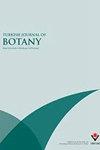废弃岩溶铝土矿尾矿区四种金属在同一属苔藓中的生物累积及土壤污染评价
IF 1.5
4区 生物学
Q3 PLANT SCIENCES
引用次数: 1
摘要
:土壤金属污染是铝土矿尾矿区的一个问题。本研究旨在通过分析硬叶Barbula rigidula(Hedw.)温和中的金属含量,有效筛选对金属污染具有较强耐受性的植物。(BR),Barbula indica(胡克)Spreng。(BI)和Barbula vinealis Brid。(BV)和土壤中。铝土矿尾矿区苔藓中金属含量依次为:Al>Fe>Zn>Cu。此外,BR中这些金属含量最高,其次是BI和BV。然而,土壤中Al(12220–87080 mg/kg)、Fe(8520–62690 mg/kg)、Cu(98.5–185.4 mg/kg)和Zn(208.2–352.6 mg/kg)的浓度大大超过了背景值。生物富集因子(BCF)分析表明,苔藓的吸收能力为0.44–1.51,其中BR的吸收能力最高,尤其是对Al和Fe的吸收能力。土壤中的金属污染因子(CF)为2.04–15.12,表明土壤受到中度至重度污染。相关分析表明,BR中Al和Fe含量与土壤呈显著正相关(r=0.898),主成分分析也证实BR是废弃岩溶铝土矿尾矿污染土壤的生物指示剂和植物修复材料。本文章由计算机程序翻译,如有差异,请以英文原文为准。
Bioaccumulation of four metals in the same genus mosses (Barbula Hedw.) and soil pollution assessment in an abandoned karst bauxite tailing area
: Soil metal pollution is a concern in bauxite tailing areas. This study aimed to effectively screen plants with strong tolerance to metal contamination by analyzing the levels of metals in Barbula rigidula (Hedw.) Mild. (BR), Barbula indica (Hook.) Spreng. (BI), and Barbula vinealis Brid. (BV) and in soils. The contents of metals in mosses obtained from the bauxite tailing area followed the following order: Al > Fe > Zn > Cu. Furthermore, the levels of these metals were highest in BR, followed by BI and BV. However, concentrations of Al (12,220–87,080 mg/kg), Fe (8520–62,690 mg/kg), Cu (98.5–185.4 mg/kg), and Zn (208.2–352.6 mg/kg) in soils greatly exceeded the background values. Bioconcentration factor (BCF) analysis showed that the uptake ability of mosses was 0.44–1.51, with BR having the highest uptake ability, especially for Al and Fe. The metal contamination factor (CF) in soils was 2.04–15.12, indicating that the soil was exposed to moderate to severe contamination. Correlation analyses found that Al and Fe levels in BR and soil were significantly positively correlated ( r = 0.898). PCA also confirmed that BR is a bioindicator and phytoremediation material of polluted soil in an abandoned karst bauxite tailing.
求助全文
通过发布文献求助,成功后即可免费获取论文全文。
去求助
来源期刊

Turkish Journal of Botany
PLANT SCIENCES-
CiteScore
2.90
自引率
5.60%
发文量
31
审稿时长
6-12 weeks
期刊介绍:
The Turkish Journal of Botany is published electronically 6 times a year by the Scientific and Technological Research Council of Turkey (TÜBİTAK) and accepts manuscripts (in English) covering all areas of plant biology (including genetics, evolution, systematics, structure, function, development, diversity, conservation biology, biogeography, paleobotany, ontogeny, functional morphology, ecology, reproductive biology, and pollination biology), all levels of organisation (molecular to ecosystem), and all plant groups and allied organisms (algae, fungi, and lichens). Authors are required to frame their research questions and discuss their results in terms of major questions in plant biology. In general, papers that are too narrowly focused, purely descriptive, or broad surveys, or that contain only preliminary data or natural history, will not be considered (*).
The following types of article will be considered:
1. Research articles: Original research in various fields of botany will be evaluated as research articles.
2. Research notes: These include articles such as preliminary notes on a study or manuscripts on the morphological, anatomical, cytological, physiological, biochemical, and other properties of plant, algae, lichen and fungi species.
3. Reviews: Reviews of recent developments, improvements, discoveries, and ideas in various fields of botany.
4. Letters to the editor: These include opinions, comments relating to the publishing policy of the Turkish Journal of Botany, news, and suggestions. Letters should not exceed one journal page.
(*) 1. Raw floristic lists (of algae, lichens, fungi, or plants), species descriptions, chorological studies, and plant sociology studies without any additional independent approaches.
2. Comparative morphology and anatomy studies (that do not cover a family, tribe, subtribe, genus, subgenus, section, subsection, or species complexes with taxonomical problems) without one or more independent additional approaches such as phylogenetical, micromorphological, chromosomal and anatomical analyses.
3. Revisions of family, tribe, genus, subgenus, section, subsection, or species complexes without any original outputs such as taxonomical status changes, IUCN categories, and phenological and ecological analyses.
4. New taxa of all plants without any additional independent approaches such as phylogenetical, ecological, chromosomal, chorological and correlational analyses in addition to a detailed macro- and micro-morphological descriptions with quality field and microscopic illustrations of taxonomically important structures and identification key in the taxonomic group.
New records of all plants without any additional independent approaches such as phylogenetical, ecological, chromosomal, chorological and correlational analyses in addition to a detailed macro- and micro-morphological descriptions with quality field and microscopic illustrations of taxonomically important structures and identification key in the taxonomic group may be accepted for peer review if they contain 3 or more new records or taxonomical status update, such as lectotypification, new combinations, transfers, revivals and synonyms.
5. New taxa of algae, lichens, and fungi without any additional independent approaches such as phylogenetical, ecological, chromosomal, chorological and correlational analyses in addition to a detailed macro- and micro-morphological descriptions with quality field and microscopic illustrations of taxonomically important structures and identification key in the taxonomic group.
New records of algae, lichens, and fungi without any additional independent approaches such as phylogenetical, ecological, chromosomal, chorological and correlational analyses in addition to a detailed macro- and micro-morphological descriptions with quality field and microscopic illustrations of taxonomically important structures and identification key in the taxonomic group may be accepted for peer review if they contain 5 or more new records or taxonomical status update, such as lectotypification, new combinations, transfers, revivals and synonyms.
 求助内容:
求助内容: 应助结果提醒方式:
应助结果提醒方式:


